Do you have a question about the MSI Z370 PC PRO and is the answer not in the manual?
Lists essential tools and components required for motherboard installation.
Step-by-step guide for installing the CPU onto the motherboard.
Instructions on how to properly install DDR4 memory modules.
Guide for connecting front panel connectors to the motherboard header.
Procedure for mounting the motherboard inside the computer chassis.
Instructions for installing SATA optical drives and hard disk drives.
Steps for installing a graphics card into the PCIe slot.
Shows how to connect external devices like keyboard, mouse, and monitor.
Guide on connecting ATX and CPU power cables to the motherboard.
Steps to power on the computer after assembly.
Details about the supported CPU generation and socket type.
Information on the motherboard's chipset.
Specifications for DDR4 memory slots and supported types.
Details on PCIe and PCI expansion slots available on the motherboard.
Information on the motherboard's integrated graphics ports and resolutions.
Specifies support for multi-GPU technologies like AMD CrossFire.
Details on SATA and M.2 storage connectors and their configurations.
Information on supported RAID levels for SATA and M.2 storage.
Specifications for USB 3.1 Gen2, Gen1, and USB 2.0 ports.
Details on the onboard audio codec and channels.
Information on the integrated Gigabit LAN controller.
Lists all connectors available on the motherboard's rear I/O panel.
Lists all internal connectors on the motherboard for various components.
Identifies the I/O controller chip.
Details on monitoring system temperatures and fan speeds.
Specifies the motherboard's physical form factor dimensions.
Information about BIOS flash memory, version, and ACPI support.
Lists included MSI software utilities for system management.
Highlights unique features like Audio Boost, Mystic Light, and Military Class 5.
Explains the meaning of LAN port LED indicators.
Overview of the audio management software interface.
Details and important notes on installing the CPU.
Information and recommendations for installing memory modules.
Describes PCIe and PCI slots, including configuration and limitations.
Instructions and important notes for installing M.2 modules.
Details SATA connectors and their compatibility with M.2 slots.
Pin definitions for front panel connectors like power and LEDs.
Information on connecting ATX power supply connectors to the motherboard.
Details the serial port connector for optional brackets.
Pinout and important notes for USB 3.1 Gen1 front panel connectors.
Pinout and important notes for USB 2.0 front panel connectors.
Explains PWM and DC fan connectors, modes, and pin definitions.
Pinout for the front panel audio connector.
Details the chassis intrusion connector and its function.
Information about the TPM module connector.
Instructions on how to reset the BIOS using the Clear CMOS jumper.
Details the parallel port connector for optional brackets.
Information about the Thunderbolt add-on card connector.
Details the RGB LED connector for LED strips.
Explains the meaning of the EZ Debug LEDs for system status.
Methods to access the BIOS setup utility.
Procedures for resetting BIOS settings to default values.
Guides for updating the BIOS using M-FLASH and Live Update 6.
Overview of the basic BIOS interface and its features.
Overview of the advanced BIOS interface and its main menus.
Details on system date, time, SATA ports, and system information.
Configuration options for PCI, PEG, ACPI, and integrated peripherals.
Settings for SATA controller operation modes like AHCI and RAID.
Settings for primary graphics adapter and shared memory.
Configuration for Thunderbolt support.
Settings for onboard USB controller and legacy support.
Configuration for serial COM ports.
Configuration for parallel LPT ports.
Settings for system power consumption and AC power loss behavior.
Settings related to Windows OS compatibility and features.
Options for enabling or disabling MSI Fast Boot for quicker startup.
Settings for Windows secure boot to prevent unauthorized access.
Configuration for system wake-up events from various sleep modes.
Settings for boot sequence, logo display, and boot mode selection.
Options for administrator/user passwords, trusted computing, and chassis intrusion.
Options for saving changes, discarding changes, and restoring defaults.
Overclocking settings for CPU, memory, and voltage adjustments.
Management of overclocking profiles, saving, and loading.
Monitoring system temperatures, fan speeds, and voltages.
Step-by-step guide for installing the Windows 10 operating system.
Instructions for installing essential motherboard drivers.
Steps for installing bundled software utilities.
Overview of the application manager for MSI software integration.
Guide to using Live Update 6 for drivers and BIOS updates.
Introduction to the Command Center software for system monitoring and control.
Explains X-BOOST for selecting system performance modes.
Guide to controlling RGB LED lighting effects on MSI products.
Tool for creating Windows installation USB drives and software RAID.
Instructions for creating a software RAID configuration.
Description of creating and using a virtual RAM disk.
Utility for traffic shaping and network bandwidth management.
Software for tuning, testing, and monitoring system performance.
Utility for gathering system information about CPU, memory, etc.
Table comparing different RAID levels (0, 1, 5, 10).
Guide to entering and using the IRST Option ROM for RAID setup.
Step-by-step instructions for creating a RAID volume.
Procedure for deleting RAID volumes and resetting disks.
How to reset RAID disks back to a non-RAID state.
Explanation of degraded RAID arrays and how to handle drive failures.
Instructions for creating M.2 PCIe SSD RAID volumes using M.2/Optane Genie or UEFI BIOS.
Lists the necessary hardware and software for Optane memory.
Step-by-step guide for installing and enabling Intel Optane memory.
Procedure to disable and remove Intel Optane memory safely.
Troubleshooting steps for no power issues.
Steps to resolve issues with no display signal.
Solutions for boot failures after BIOS updates.
How to recover from a lost BIOS password.
Troubleshooting steps for audio issues.
Steps to resolve network connectivity problems.
Troubleshooting steps for non-functional USB devices.
Compliance statement regarding FCC regulations for digital devices.
Information regarding CE marking and EU directives compliance.
Compliance statement regarding C-Tick regulations.
Information on battery disposal and handling.
Information on chemical substances in compliance with regulations.
MSI's policy on product recycling and environmental protection.
Statement regarding waste electrical and electronic equipment disposal.
Lists essential tools and components required for motherboard installation.
Step-by-step guide for installing the CPU onto the motherboard.
Instructions on how to properly install DDR4 memory modules.
Guide for connecting front panel connectors to the motherboard header.
Procedure for mounting the motherboard inside the computer chassis.
Instructions for installing SATA optical drives and hard disk drives.
Steps for installing a graphics card into the PCIe slot.
Shows how to connect external devices like keyboard, mouse, and monitor.
Guide on connecting ATX and CPU power cables to the motherboard.
Steps to power on the computer after assembly.
Details about the supported CPU generation and socket type.
Information on the motherboard's chipset.
Specifications for DDR4 memory slots and supported types.
Details on PCIe and PCI expansion slots available on the motherboard.
Information on the motherboard's integrated graphics ports and resolutions.
Specifies support for multi-GPU technologies like AMD CrossFire.
Details on SATA and M.2 storage connectors and their configurations.
Information on supported RAID levels for SATA and M.2 storage.
Specifications for USB 3.1 Gen2, Gen1, and USB 2.0 ports.
Details on the onboard audio codec and channels.
Information on the integrated Gigabit LAN controller.
Lists all connectors available on the motherboard's rear I/O panel.
Lists all internal connectors on the motherboard for various components.
Identifies the I/O controller chip.
Details on monitoring system temperatures and fan speeds.
Specifies the motherboard's physical form factor dimensions.
Information about BIOS flash memory, version, and ACPI support.
Lists included MSI software utilities for system management.
Highlights unique features like Audio Boost, Mystic Light, and Military Class 5.
Explains the meaning of LAN port LED indicators.
Overview of the audio management software interface.
Details and important notes on installing the CPU.
Information and recommendations for installing memory modules.
Describes PCIe and PCI slots, including configuration and limitations.
Instructions and important notes for installing M.2 modules.
Details SATA connectors and their compatibility with M.2 slots.
Pin definitions for front panel connectors like power and LEDs.
Information on connecting ATX power supply connectors to the motherboard.
Details the serial port connector for optional brackets.
Pinout and important notes for USB 3.1 Gen1 front panel connectors.
Pinout and important notes for USB 2.0 front panel connectors.
Explains PWM and DC fan connectors, modes, and pin definitions.
Pinout for the front panel audio connector.
Details the chassis intrusion connector and its function.
Information about the TPM module connector.
Instructions on how to reset the BIOS using the Clear CMOS jumper.
Details the parallel port connector for optional brackets.
Information about the Thunderbolt add-on card connector.
Details the RGB LED connector for LED strips.
Explains the meaning of the EZ Debug LEDs for system status.
Methods to access the BIOS setup utility.
Procedures for resetting BIOS settings to default values.
Guides for updating the BIOS using M-FLASH and Live Update 6.
Overview of the basic BIOS interface and its features.
Overview of the advanced BIOS interface and its main menus.
Details on system date, time, SATA ports, and system information.
Configuration options for PCI, PEG, ACPI, and integrated peripherals.
Settings for SATA controller operation modes like AHCI and RAID.
Settings for primary graphics adapter and shared memory.
Configuration for Thunderbolt support.
Settings for onboard USB controller and legacy support.
Configuration for serial COM ports.
Configuration for parallel LPT ports.
Settings for system power consumption and AC power loss behavior.
Settings related to Windows OS compatibility and features.
Options for enabling or disabling MSI Fast Boot for quicker startup.
Settings for Windows secure boot to prevent unauthorized access.
Configuration for system wake-up events from various sleep modes.
Settings for boot sequence, logo display, and boot mode selection.
Options for administrator/user passwords, trusted computing, and chassis intrusion.
Options for saving changes, discarding changes, and restoring defaults.
Overclocking settings for CPU, memory, and voltage adjustments.
Management of overclocking profiles, saving, and loading.
Monitoring system temperatures, fan speeds, and voltages.
Step-by-step guide for installing the Windows 10 operating system.
Instructions for installing essential motherboard drivers.
Steps for installing bundled software utilities.
Overview of the application manager for MSI software integration.
Guide to using Live Update 6 for drivers and BIOS updates.
Introduction to the Command Center software for system monitoring and control.
Explains X-BOOST for selecting system performance modes.
Guide to controlling RGB LED lighting effects on MSI products.
Tool for creating Windows installation USB drives and software RAID.
Instructions for creating a software RAID configuration.
Description of creating and using a virtual RAM disk.
Utility for traffic shaping and network bandwidth management.
Software for tuning, testing, and monitoring system performance.
Utility for gathering system information about CPU, memory, etc.
Table comparing different RAID levels (0, 1, 5, 10).
Guide to entering and using the IRST Option ROM for RAID setup.
Step-by-step instructions for creating a RAID volume.
Procedure for deleting RAID volumes and resetting disks.
How to reset RAID disks back to a non-RAID state.
Explanation of degraded RAID arrays and how to handle drive failures.
Instructions for creating M.2 PCIe SSD RAID volumes using M.2/Optane Genie or UEFI BIOS.
Lists the necessary hardware and software for Optane memory.
Step-by-step guide for installing and enabling Intel Optane memory.
Procedure to disable and remove Intel Optane memory safely.
Troubleshooting steps for no power issues.
Steps to resolve issues with no display signal.
Solutions for boot failures after BIOS updates.
How to recover from a lost BIOS password.
Troubleshooting steps for audio issues.
Steps to resolve network connectivity problems.
Troubleshooting steps for non-functional USB devices.
Compliance statement regarding FCC regulations for digital devices.
Information regarding CE marking and EU directives compliance.
Compliance statement regarding C-Tick regulations.
Information on battery disposal and handling.
Information on chemical substances in compliance with regulations.
MSI's policy on product recycling and environmental protection.
Statement regarding waste electrical and electronic equipment disposal.
| Form Factor | ATX |
|---|---|
| Socket | LGA 1151 |
| Chipset | Intel Z370 |
| Memory Type | DDR4 |
| Memory Slots | 4 |
| Maximum Memory | 64 GB |
| PCIe 3.0 x16 Slots | 2 |
| PCIe 3.0 x1 Slots | 3 |
| SATA 6Gb/s | 6 |
| M.2 Slots | 2 |
| USB 3.1 Gen1 (Rear) | 2 |
| USB 3.1 Gen2 (Rear) | 1 |
| USB 2.0 (Rear) | 2 |
| USB 3.1 Gen2 | 1 (Type A) |
| LAN | 1 x Realtek RTL8111H Gigabit LAN |
| Memory Speed | DDR4-4000+(OC) |
| USB 2.0 | 6 (2 ports on the back panel, 4 ports available through the internal USB connectors) |
| Audio | Realtek ALC892 Codec, 7.1-Channel High Definition Audio |
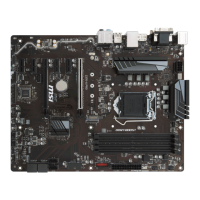



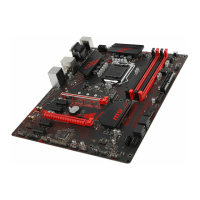
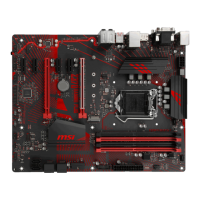

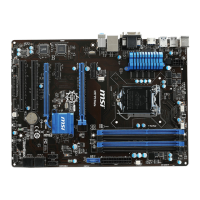

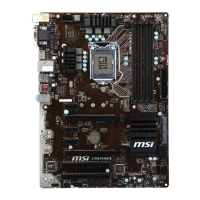


